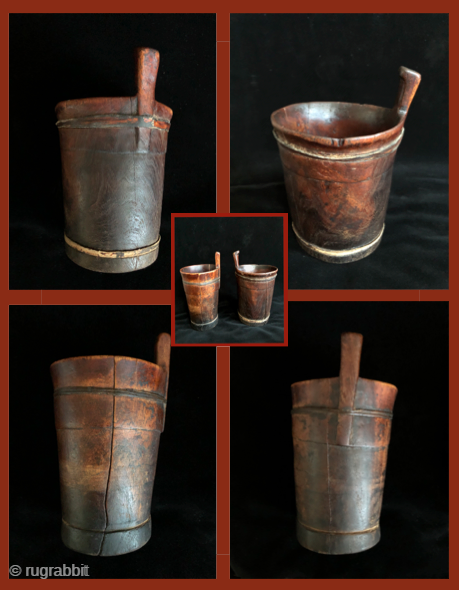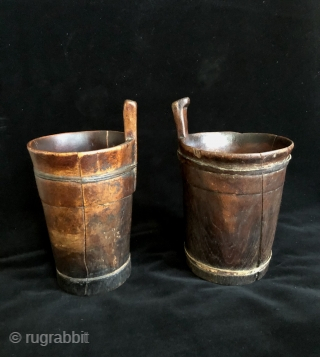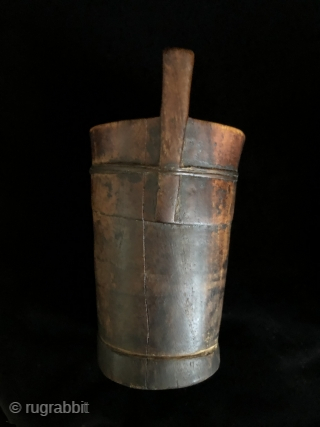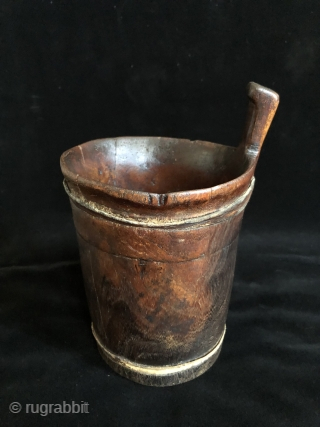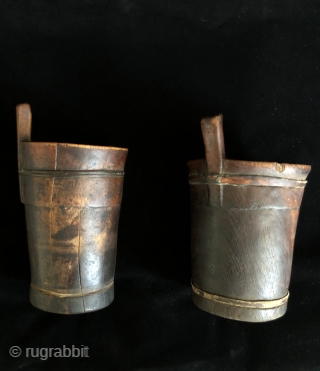Back
Two ancient Wooden Drinking vessels (kero) from the altiplano region of Bolivia. Ritual drinking and feasting was a vital part of Andean culture and was the glue that fostered and cemented relationships and alliances. The drinking of chica or fermented corn beer was so institutionalized that special drinking vessels were required. The kero form was created by about 300 - 400 a.d. in the Lake Titicaca Basin by the Tiwanaku culture and was the vessel designated for chicha drinking. Kero's were made from ceramic, metal, stone and wood. These two keros probably date to the period between a.d 600 - 900. They show what is referred to as a "boss" on the top rim that acted as a handle and often represented a stylized animal head. These vessels both have a rawhide band wrapped around them meant to prevent them from splitting open. However, time and the dry environment of the region has won out in the case of these two and cracks appeared probably centuries ago. Both were carved from a single block of hard wood - a commodity that had to be traded into the region because the altiplano was above tree line at 12,500 feet above sea level. These keros were not likely made for the elite who would have required precious metal or fine ceramic ware for their drinking. These have a rugged and authentic feel to them and standing at nearly 10 inches tall they are very large examples capable of holding a robust amount of the potent fermented beverage. Cheers!
price:
inquire jameswblackmon@gmail.com
- Home
- Antique Rugs by Region
- Category
- Profiles
- Post Items Free
- Albums
- Benaki Museum of Islamic Art
- Budapest: Ottoman Carpets
- Gulbenkian Museum
- Islamic Carpets. Brooklyn
- Islamic Textiles. Brooklyn
- Konya Museum: Rugs
- MKG, Hamburg
- MMA: Caucasian Carpets
- MMA: Mamluk Carpets
- MMA: Mughal Indian Carpets
- MMA: Ottoman Carpets
- MMA: Safavid Persian Carpets
- MMA: Turkmen Rugs
- McCoy Jones Kilims
- Ottoman textiles. Met
- Philadelphia Museum
- Rugs and Carpets: Berlin
- Seljuqs at the Met
- TIEM, Istanbul: Carpets
- V&A: Classical Carpets
- Vakiflar Carpets: Istanbul
- Baluch Rugs: Indianapolis
- Gallery Exhibitions
- Jaf an Exhibition
- Alberto Levi Gallery
- Andean Textile
- Christie's London: 2016
- Francesca Galloway
- HALI at 40
- ICOC Washington, DC 2018
- Jajims of the Shahsavan
- London Islamic Week April, 2018
- Mongolian Felts
- Navajo Rugs: JB Moore
- Persian Piled Weavings
- SF Tribal & Textile Art Show 2020
- SF Tribal 2019
- Sotheby's: C. Alexander
- Turkish Prayer Rugs
- Turkmen Main Carpets ICOC 2007








